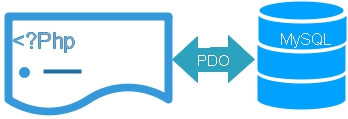PHP MySQL connection using PDO
 Before using database we need to connect it first. This process is common in all types of database irrespective of language we use. We will learn here the code for connecting to MySQL database using PDO class.
Before using database we need to connect it first. This process is common in all types of database irrespective of language we use. We will learn here the code for connecting to MySQL database using PDO class.
PHP Data Object PDO installation or enable and creating connection string to manage MySQL database
It is always a good practice to keep the database connection details at a common place and call it from different pages where it is required. This helps in maintaining the code when the database connection details changes or the script is shifted to different server with different connection details. If we are not using a common file then to change the database details we need not change the connection string in all the files. By keeping all details at one place if we update the details then all the files will use the same ( updated ) details.

We can keep the connection details in config.php file or any other file name you find suitable. All the codes inside this file are to be within the PHP code block, so it will not be exposed if it is opened directly in browser.
Let us start with the basic connection code in PDO for PHP & MySQL ( PHP MySQL Connection code for old system is here )
config.php
The code below is kept inside config.php file and can be connected from any other file in the script.<?php
// Database Connection Configuration
// Use either MySQL or SQLite by uncommenting the respective section
$host_name = "localhost";
$database = "pdo"; // Change this to your actual database name
$username = ""; // Your MySQL database username
$password = ""; // Your MySQL database password
//////// Establish Connection to MySQL Database ////////
try {
$dbo = new PDO('mysql:host='.$host_name.';dbname='.$database, $username, $password);
} catch (PDOException $e) {
print("Error!: " . $e->getMessage() . "<br/>");
die();
}
///// For SQLite Database Connection /////
// Uncomment the line below to switch to SQLite
// $dbo = new PDO('sqlite:' . dirname(__FILE__) . '/my_student.db');
?>
Common file config.php to keep all database connection details and connected from all script pages.
Here the variables $host_name is the name of the MySQL server host or ip address ( 'localhost' or '127.0.0.1')
To get the database connection we have to keep these two lines inside any file and start using the database
require "config.php";Example 2: Connecting to a PostgreSQL Database Using PHP PDO
Connecting to a PostgreSQL database with PDO is similar to MySQL but requires a different DSN. Here’s an example:
<?php
try {
$dbo = new PDO('pgsql:host=localhost;dbname=testdb', 'username', 'password');
$dbo->setAttribute(PDO::ATTR_ERRMODE, PDO::ERRMODE_EXCEPTION);
echo "Connection successful!";
} catch (PDOException $e) {
echo "Connection failed: " . $e->getMessage();
}
?>
Example 3: Setting Connection Timeout in PDO
It’s possible to define a connection timeout by setting the ATTR_TIMEOUT attribute:
<?php
$dbo = new PDO('mysql:host=localhost;dbname=testdb', 'username', 'password');
$dbo->setAttribute(PDO::ATTR_TIMEOUT, 5); // Timeout set to 5 seconds
?>
Example 4: Using Persistent Connections in PDO
Persistent connections improve performance by reusing the same connection rather than opening a new one each time:
<?php
$dbo = new PDO('mysql:host=localhost;dbname=testdb', 'username', 'password', array(
PDO::ATTR_PERSISTENT => true
));
?>
Handling Connection Errors Gracefully
Handling connection errors in a structured way helps improve user experience and debugging:
<?php
try {
$dbo = new PDO('mysql:host=localhost;dbname=testdb', 'username', 'password');
$dbo->setAttribute(PDO::ATTR_ERRMODE, PDO::ERRMODE_EXCEPTION);
echo "Connection successful!";
} catch (PDOException $e) {
error_log("Connection failed: " . $e->getMessage()); // Log the error
echo "Database connection could not be established.";
}
?>
Google Cloud & MySQL connection using PDO
<?Php
$host_name = "34.68.103.244";
$database = "my_tutorial"; // Change your database name
$username = "root-plus2net"; // Your database user id
$password = "************"; // Your password
//////// Do not Edit below /////////
try {
$dbo = new PDO('mysql:host='.$host_name.';dbname='.$database, $username, $password);
} catch (PDOException $e) {
print "Error!: " . $e->getMessage() . "<br/>";
die();
}
/// Sample script to display records ////
$sql="select * from student ";
echo "<table>";
foreach ($dbo->query($sql) as $row) {
echo "<tr ><td>$row[name]</td></tr>";
}
echo "</table>";
?>More on Managing MySQL database at Google cloud
Download Zip file to test your PHP PDO script
Subhendu Mohapatra
Author
🎥 Join me live on YouTubePassionate about coding and teaching, I publish practical tutorials on PHP, Python, JavaScript, SQL, and web development. My goal is to make learning simple, engaging, and project‑oriented with real examples and source code.
Subscribe to our YouTube Channel here
This article is written by plus2net.com team.
https://www.plus2net.com

02-10-2021 | |
| cant we connect to a phpmyadmin sql database? | |
